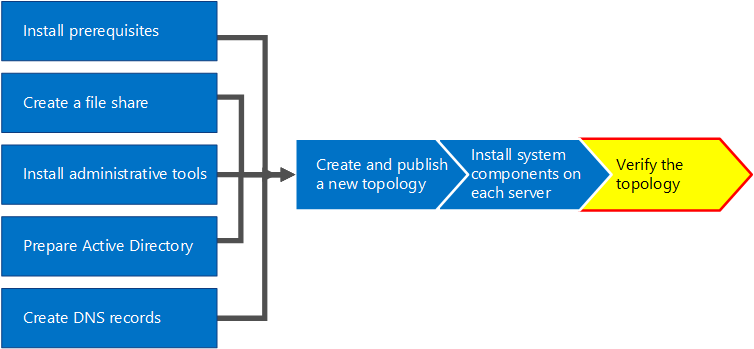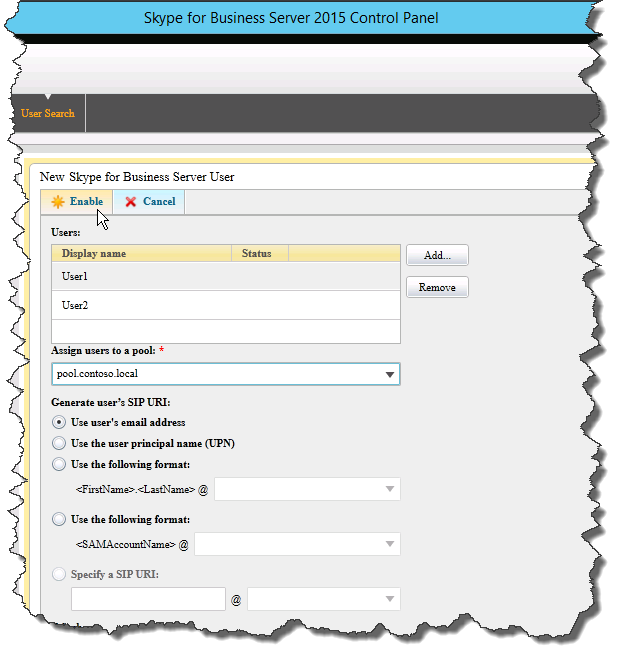Note
Access to this page requires authorization. You can try signing in or changing directories.
Access to this page requires authorization. You can try changing directories.
APPLIES TO:  2015
2015  2019
2019  Subscription Edition
Subscription Edition
Summary: Learn how to verify the Skype for Business Server topology and Active Directory servers are working as expected.
After you have the topology published and the Skype for Business Server system components installed on each of the servers in the topology, you're ready to verify that the topology is working as expected. This includes verifying that the configuration has propagated out to all of the Active Directory servers so that the entire domain knows Skype for Business is available in the domain. You can do steps 1 through 5 in any order. However, you must do steps 6, 7, and 8 in order, and after steps 1 through 5, as outlined in the diagram. Verifying the topology is step 8 of 8.

Test the Front End pool deployment
The final step is to test the Front End pool and confirm that Skype for Business clients can communicate with each other.
Add users and verify client connectivity
Use Active Directory Computers and Users to add the Active Directory user object of the administrator role for the Skype for Business Server deployment (on which Skype for Business Server Control Panel is installed) to the CSAdministrator group.
Important
If you don't add the appropriate users and groups to the CsAdministors group, you'll receive an error when you open Skype for Business Server Control Panel which reads, "Unauthorized: Access is denied due to a role-based access control (RBAC) authorization failure."
If the user object is currently logged on, log off and then log on again to register the new group assignment.
Note
The user account can't be the local administrator of any server running Skype for Business Server.
Use the administrative account to log on to the computer where Skype for Business Server Control Panel is installed.
Start Skype for Business Server Control Panel, and then provide credentials, if prompted. Skype for Business Server Control Panel displays deployment information.
In the left navigation bar, click Topology, and then confirm that the service status shows a computer with a green arrow and that a green check mark for replication status is next to each Skype for Business Server role that has been deployed and brought online.
In the left navigation bar, click Users, and then click Enable users.
On the New Skype for Business Server User page, click Add.
To define search parameters for the objects you want to find, on the Select from Active Directory page, you can select Search, and then optionally click Add Filter. You can also select LDAP search and enter an LDAP expression to filter or limit the objects that will be returned. After you have decided on your Search options, click Find.
In the Search results pane, select the users you want to add, and then click OK.
On the New Skype for Business Server User page, the users you selected are in the Users display. In the Assign users to a pool list, select the server where the users should reside.
The following is a list of options you can use to configure the objects.
Generate user's SIP URI
Telephony
Line URI
Conferencing policy
Client version policy
PIN policy
External access policy
Archiving policy
Location policy
Client policy
To test the basic functionality, select the option you prefer for the Generate user's SIP URI setting (the other options in the configuration use default settings), and then click Enable, as shown in the figure.

A summary page is displayed that shows a check mark in the Enabled column to indicate that the users are set up. The SIP address column displays the address you need for the user sign-in configuration.

Log one user on to a computer that is joined to the domain and another user on to another computer in the domain.
Install Skype for Business client on each of the two client computers, and then verify that both users can sign in to Skype for Business Server and can send instant messages to each other.